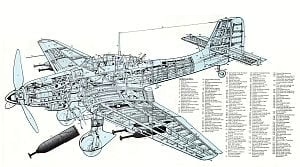Junkers Ju 87 Stuka History
When first committed to combat, the Junkers Ju 87 Stuka – a derivation of Sturzkampfflugzeug which was a term descriptive of all dive bombers – was widely believed by its advocates, not least among whom was Ernst Udet, to be the supreme weapon. The legendary reputation that it acquired during the Polish and French campaigns lent credence to claims for its invincibility so assiduously propagated. But the Stuka was not solely a highly effective precision bombing instrument which, if not capable of ‘putting a bomb in a pickle barrel’, was at least able to hit its target in a diving attack with an accuracy of less than 30 yards; it was a mass demoraliser, hurtling vertically earthwards with a banshee-like wail that had a devastating psychological effect.
The concept of the Sturzkampffluzeug originated in World War One when the Germans formed specialist ground attack squadrons units known as Schlachtstaffeln. In March 1918, at the time of the Ludendorf Offensive on the Western Front, 27 of these units were operational in support of the various German field armies, and their quickly learned that the light bombs carried by their aircraft could be placed more accurately by making a diving attack rather than releasing them in level flight.
From its inception, the Luftwaffe had displayed a marked predilection for the Junkers Ju 87 Stuka. The service was first and foremost a tool for the direct support of the ground forces and the Stuka was seen as a successor to long-range artillery. Unfortunately for the Luftwaffe, use of the Ju 87 Stuka presupposed control of the air; a desirable situation that was to be enjoyed increasingly rarely as the conflict progressed.
The Ju 87 will always be associated with victorious German blitzkrieg tactics employed in Poland and France during the first year of WW II; campaigns that fulfilled the most sanguine expectations of the Stuka’s protagonists. Its first encounter with determined fighter opposition was during the Battle of Britain. This forced the withdrawal of the Junkers Ju 87 Stuka-equipped Stukagruppen from the Cherbourg area to the Pas de Calais where they were to sit out the final phases of that epic conflict, pricked the Ju 87’s bubble of success and revealed the fact that this aircraft had become an anachronism in the context of fighting in the West. But the day of the Stuka was far from over, for the Ju 87 was to enjoy further success wherever the Luftwaffe succeeded in maintaining a measure of mastery in the air, the Stukagruppen ensuring that even the Soviet campaign initially proved a repetition of the debacle suffered by the French.
When the production of the Junkers Ju 87 Stuka series finally ended in September 1944, more than five thousand seven hundred of these aircraft had been built.
Junkers Ju 87 Stuka Specifications
| Aircraft Type: |
| dive-bomber airplane |
| Dimensions: |
| wingspan: 49 ft, 2 in |
| length: 37 ft, 8 in |
| height: 12 ft, 9 in |
| Weights: |
| empty: 8,686 lb |
| gross: 14,550 lb |
| Power plant: |
| 1 × 1,500 hp Junkers Jumo 211P liquid-cooled in-line engine |
| Performance: |
| maximum speed: 248 mph |
| ceiling: 27,885 ft |
| maximum range: 410 mi |
| Armament: |
| 2 × 7.92 mm calibre machine guns |
| 2 × 20 mm calibre cannons |
| up to 6,000 lb of bombs |
| Operational Use: |
| 1936–1945 |








